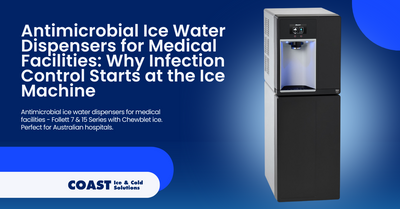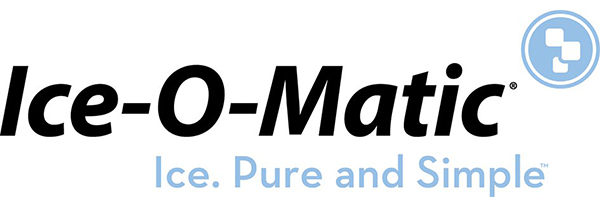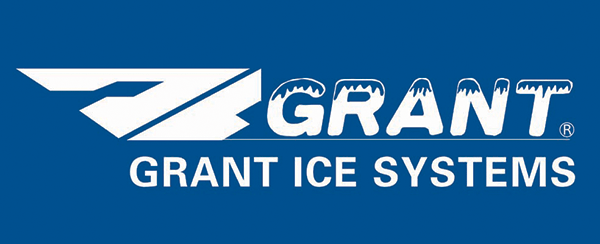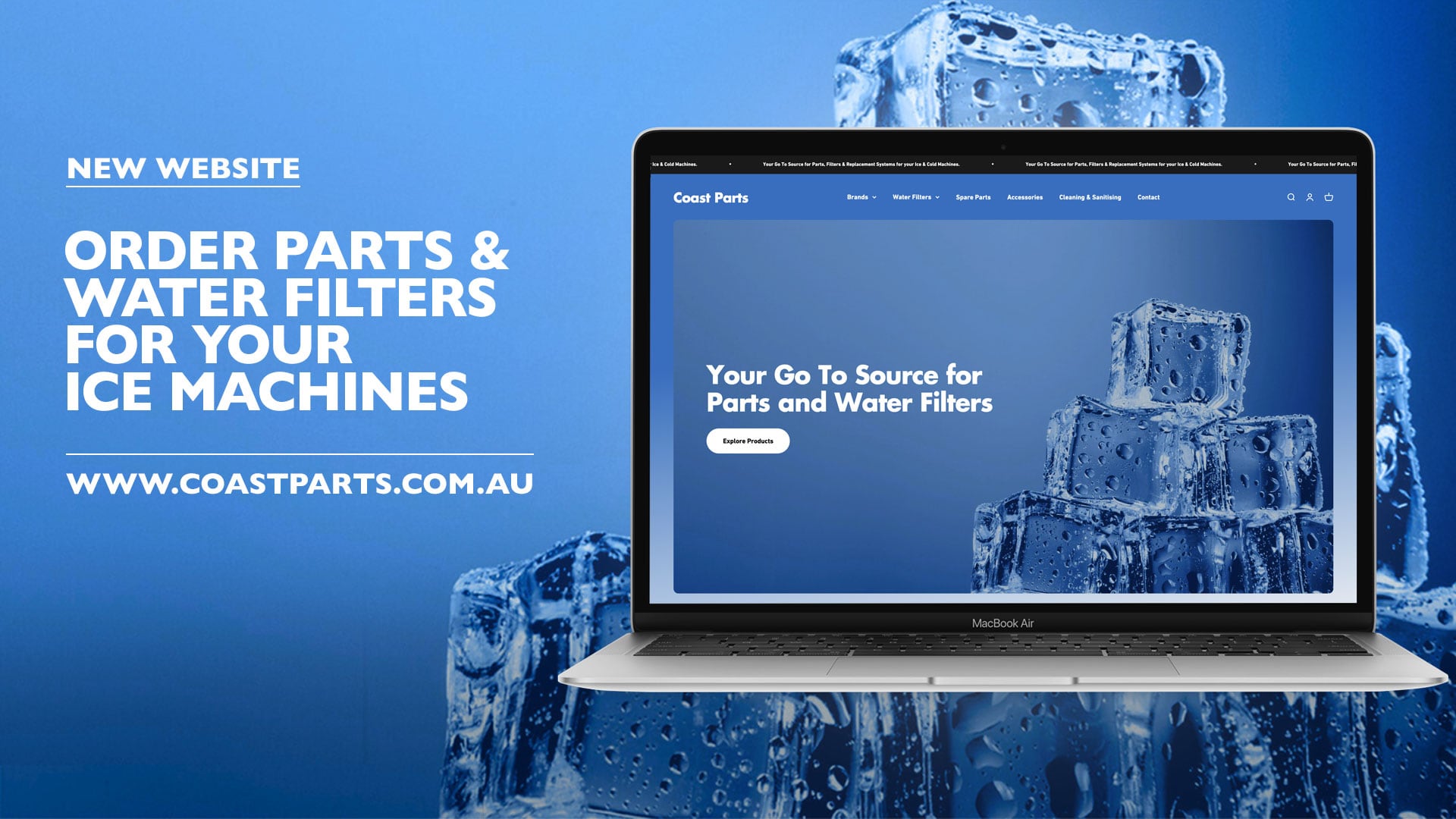Antimicrobial Ice Water Dispensers for Medical Facilities: Why Infection Control Starts at the Ice Machine
The Coast Team on 22nd Jul 2025
You're the infection control officer at a busy Sydney hospital. It's 2 AM, and you've just discovered that the ice machine in the cardiac ward – the one touched by dozens of hands daily – has become a bacterial hotspot. Despite regular cleaning protocols, traditional ice dispensers remain one of the most overlooked vectors for cross-contamination in healthcare settings. If this scenario keeps you up at night, you're not alone.
Antimicrobial ice water dispensers represent a fundamental shift in how medical facilities approach infection control. The Follett 7 & 15 Series incorporate antimicrobial treatments and touchless operation specifically designed for healthcare environments where every surface matters and every interaction counts.
The Hidden Risk of Traditional Ice Dispensers in Healthcare
Let's address the elephant in the room: ice machines in hospitals are germ magnets. Think about it – multiple staff members accessing the same unit throughout their shifts, hands that have just removed gloves after patient care, the rush of emergency situations where proper hand hygiene takes a backseat to immediate patient needs.
Research consistently shows that ice and ice machines can harbour pathogens including:
- Pseudomonas aeruginosa
- Enterobacter species
- Candida species
- Various environmental bacteria
In Australian healthcare facilities, where we're dealing with increasingly resistant organisms and vulnerable patient populations, the risk isn't theoretical – it's a daily reality. From the Royal Melbourne Hospital to small aged care facilities in regional Queensland, infection control teams battle the same challenge: how do you provide safe, accessible ice without creating another contamination point?
This is where antimicrobial ice water dispensers change the game. By incorporating antimicrobial treatments into the equipment design and adding touchless operation, these units address contamination at its source rather than relying solely on cleaning protocols.
Understanding Antimicrobial Technology in Healthcare Ice Equipment
When Coast Distributors mentions antimicrobial treatment in their Follett units, what does this actually mean for your facility? While specific coating details aren't publicly available, antimicrobial treatments in medical equipment typically work by creating surfaces hostile to microbial growth between cleaning cycles.
Here's what matters for Australian healthcare facilities:
- The antimicrobial treatment provides continuous protection between scheduled cleanings
- It supplements, not replaces, standard cleaning and sanitisation protocols
- The treatment targets high-touch surfaces where contamination risk is highest
The real value becomes clear during those inevitable busy periods – a Code Blue in the emergency department, a gastro outbreak in aged care, or simply a particularly hectic night shift. When cleaning schedules slip or hand hygiene compliance drops, antimicrobial surfaces provide an additional barrier against pathogen transmission.
Touchless Operation: The Feature That Changes Everything
Perhaps the most significant advancement in the Follett E7CI114A and its counterparts is touchless sensor operation. Coast Distributors specifically highlights how this "allows users to operate the machine without touching any buttons, ensuring that the machine is hygienic to use."
Consider the typical ice dispensing scenario in an Australian hospital:
- Nurse finishes wound care procedure
- Removes gloves and performs hand hygiene
- Needs ice for patient hydration
- Touches dispenser controls with clean hands
- Next staff member approaches with potentially contaminated hands
- Cycle continues across three shifts
Touchless operation breaks this chain. Staff can dispense ice without physical contact, maintaining the integrity of their hand hygiene and preventing surface contamination. For facilities struggling with hand hygiene compliance rates – and let's be honest, which facility isn't? – this removes a critical touchpoint from the equation.
Chewblet Ice: More Than Just Frozen Water in Medical Settings
The Follett 7 & 15 Series units produce what Coast Distributors calls "Consumer Preferred Chewblet ice" – those soft, chewable nuggets that are "the perfect size and shape for bedside carafes." But in medical facilities, the benefits go far beyond preference.
Patient Safety Benefits:
- Reduced choking risk for elderly patients
- Easier to manage for patients with swallowing difficulties
- Safer for post-surgical patients with limited jaw mobility
- Appropriate texture for patients with cognitive impairment
Clinical Applications:
- Ideal for dysphagia management protocols
- Suitable for patients on thickened fluids
- Effective for fever management without hard ice risks
- Appropriate for paediatric units where ice size matters
In aged care facilities across Australia, where swallowing difficulties affect a significant portion of residents, Chewblet ice can mean the difference between adequate hydration and dehydration risks. The soft texture encourages consumption while minimising aspiration concerns.
Capacity Considerations for Australian Medical Facilities
The 54.4kg daily production capacity of these units deserves careful consideration. In the context of Australian healthcare:
7 Series Units (E7UC114A Undercounter):
- 54.4kg daily production
- 3.2kg storage capacity
- Suitable for single ward or department use
- Ideal for facilities with distributed ice needs
15 Series Units (E15FS114A Freestanding):
- 54.4kg daily production
- 6.8kg storage capacity
- Better for high-traffic areas
- Appropriate for centralised ice distribution points
A 30-bed medical ward in Brisbane might consume 40-60kg of ice daily during summer months. The production capacity handles this demand, but the storage difference between series becomes critical during peak usage periods. Morning medication rounds can deplete the 3.2kg storage quickly, while the 6.8kg buffer of the 15 Series provides breathing room.
Installation Configurations: Matching Equipment to Healthcare Spaces
Australian medical facilities face unique space challenges. Heritage hospital buildings in Melbourne, purpose-built aged care facilities in Perth, and cramped regional health centres all have different infrastructure constraints. The three configurations available address these realities:
Countertop Installation (E7CI114A):
- Preserves floor space in tight nurses' stations
- Provides easy access for staff of all abilities
- Simple retrofit into existing spaces
- Visible reminder for cleaning protocols
Undercounter Installation (E7UC114A):
- Maximises workspace in medication rooms
- Maintains clean sight lines in patient areas
- Ideal for new builds with planned infrastructure
- Reduces infection control audit points at eye level
Freestanding Units (E15FS114A):
- Flexible placement without renovation
- Larger storage reduces refill frequency
- Easier access for cleaning and maintenance
- Suitable for facilities without built-in options
Infection Control Protocols and Antimicrobial Equipment
Having antimicrobial ice water dispensers doesn't eliminate the need for rigorous cleaning protocols, but it does change how facilities approach infection control. Australian healthcare facilities operating under strict infection control standards benefit from a multi-layered approach:
Daily Cleaning Requirements:
- External surface wipe-downs remain essential
- Touchless operation reduces contamination between cleans
- Antimicrobial surfaces inhibit growth if cleaning is delayed
- Focus shifts to ice contact surfaces rather than controls
Weekly Deep Cleaning:
- Systematic sanitisation of ice storage areas
- Verification of sensor operation
- Assessment of antimicrobial surface integrity
- Documentation for infection control audits
Monthly Audits:
- Microbial testing of ice samples
- Surface swabs of high-touch areas
- Sensor calibration checks
- Compliance verification with facility protocols
The combination of antimicrobial treatment and touchless operation means cleaning staff can focus their efforts where they matter most, rather than constantly sanitising control panels and buttons.
Real-World Applications Across Australian Healthcare Settings
Different medical facilities use antimicrobial ice water dispensers in various ways:
Major Metropolitan Hospitals: Place units strategically in high-risk areas like ICU, oncology wards, and transplant units where immunocompromised patients face the greatest risk from environmental pathogens. The touchless operation proves invaluable during barrier nursing protocols.
Regional Hospitals: With limited staff and resources, these facilities benefit from equipment that maintains hygiene standards between cleaning cycles. The antimicrobial protection provides peace of mind when cleaning staff are stretched thin.
Aged Care Facilities: Beyond infection control, the Chewblet ice addresses swallowing safety concerns prevalent in dementia units. Touchless operation also helps when residents with cognitive impairment attempt to operate equipment independently.
Day Surgery Centres: With rapid patient turnover and staff moving between sterile and non-sterile areas, touchless ice dispensing prevents cross-contamination during busy periods. The antimicrobial surfaces handle the high-frequency use typical of these facilities.
Rehabilitation Centres: Ice serves dual purposes here – hydration and therapy. Antimicrobial protection becomes crucial when the same ice is used for consumption and therapeutic applications.
Compliance with Australian Healthcare Standards
While specific certifications weren't accessible on the Coast Distributors website, antimicrobial ice water dispensers in medical facilities must align with various Australian standards and guidelines:
Relevant Standards to Consider:
- AS/NZS 4187 for reprocessing of reusable medical devices
- NSQHS Standards for infection prevention and control
- State-based health department guidelines
- Food Standards Australia New Zealand requirements for ice as food
The touchless operation and antimicrobial features directly support compliance with infection control standards, particularly around:
- Hand hygiene protocols
- Environmental cleaning requirements
- Prevention of healthcare-associated infections
- Food safety in healthcare settings
Facilities implementing these units should document how the antimicrobial and touchless features support their infection control strategies during accreditation processes.
Cost-Benefit Analysis for Healthcare Facilities
When evaluating antimicrobial ice water dispensers, Australian healthcare facilities must consider both direct costs and indirect benefits:
Investment Considerations:
- Initial equipment purchase
- Installation and infrastructure modifications
- Staff training on touchless operation
- Integration with existing infection control protocols
Quantifiable Benefits:
- Reduced infection rates (even marginal improvements save significant costs)
- Decreased cleaning chemical usage on control surfaces
- Lower staff sick leave from acquired infections
- Improved audit outcomes and compliance scores
Intangible Benefits:
- Enhanced patient and family confidence
- Reduced staff stress about contamination risks
- Simplified infection control training
- Positive impact on facility reputation
For a 100-bed aged care facility in Adelaide, preventing even one outbreak of gastrointestinal infection could offset the entire equipment investment. The touchless operation alone reduces thousands of potentially contaminating touches annually.
Training Staff on Antimicrobial Equipment Features
Introducing antimicrobial ice water dispensers requires more than installation – it demands comprehensive staff education:
Key Training Points:
- Antimicrobial doesn't mean self-cleaning
- Touchless operation requires proper positioning
- Regular cleaning remains mandatory
- Ice quality depends on water quality
Common Misconceptions to Address:
- "Antimicrobial surfaces don't need cleaning" (they do)
- "Touchless means completely hands-free" (bins still need filling)
- "All bacteria are eliminated" (reduction, not elimination)
- "Any water source is fine" (filtration still matters)
Successful implementation in facilities from Cairns to Hobart shows that proper training dramatically improves outcomes. Staff who understand the technology use it more effectively and maintain it properly.
Water Quality Considerations for Medical Ice
Even with antimicrobial protection and touchless operation, water quality remains fundamental. Australian water varies dramatically:
Regional Variations:
- Sydney: Generally good quality, minimal treatment needed
- Adelaide: Hard water requires robust filtration
- Perth: Seasonal variations demand flexible filtration
- Regional areas: Bore water may need extensive treatment
Medical facilities must ensure incoming water meets standards before it becomes ice. Antimicrobial treatments protect against surface contamination but don't address waterborne pathogens. Proper filtration remains non-negotiable.
Future-Proofing Healthcare Ice Systems
As Australian healthcare evolves, antimicrobial ice water dispensers position facilities for emerging challenges:
Antibiotic Resistance: With growing concerns about multi-resistant organisms, equipment that reduces transmission pathways becomes increasingly valuable.
Ageing Population: More patients with swallowing difficulties and compromised immune systems make safe ice production critical.
Staffing Pressures: Touchless operation becomes more important as facilities struggle with staffing ratios and cleaning resources.
Regulatory Evolution: Infection control standards continue tightening, making proactive equipment choices wise investments.
Making the Right Choice for Your Medical Facility
Selecting between the available models depends on your specific needs:
Choose Countertop (E7CI114A) for:
- Single department installation
- Facilities with adequate bench space
- Areas requiring visible hygiene features
- Departments with frequent audits
Choose Undercounter (E7UC114A) for:
- Space-constrained nurses' stations
- New builds with planned infrastructure
- Areas where aesthetics matter
- Facilities prioritising workspace
Choose Freestanding (E15FS114A) for:
- High-volume ice requirements
- Flexible placement needs
- Centralised ice distribution
- Facilities without built-in options
Remember that all three models provide the same antimicrobial treatment and touchless operation – the choice comes down to your facility's physical constraints and usage patterns.
Ready to enhance infection control with antimicrobial ice water dispensers in your medical facility?
Contact Coast Distributors to discuss which Follett dispenser suits your healthcare needs:
• View the Follett E7CI114A Countertop specifications
• View the Follett E7UC114A Undercounter specifications
• View the Follett E15FS114A Freestanding specifications
• Explore our complete range of 7 & 15 Series antimicrobial ice solutions
• Speak with our expert team by filling out our contact form
• Need a service for your machine: fill out our service request form
• Need water filters or spare parts? Browse our parts inventory
Don't let ice dispensers become infection control weak points in your facility. Join the growing number of Australian medical facilities already benefiting from antimicrobial protection and touchless operation. Coast Distributors is Australia's exclusive Follett distributor, providing healthcare ice solutions nationwide. With 24-hour service support and extensive medical facility experience, we ensure your ice equipment supports optimal infection control standards. Visit coastdistributors.com.au to learn more.









